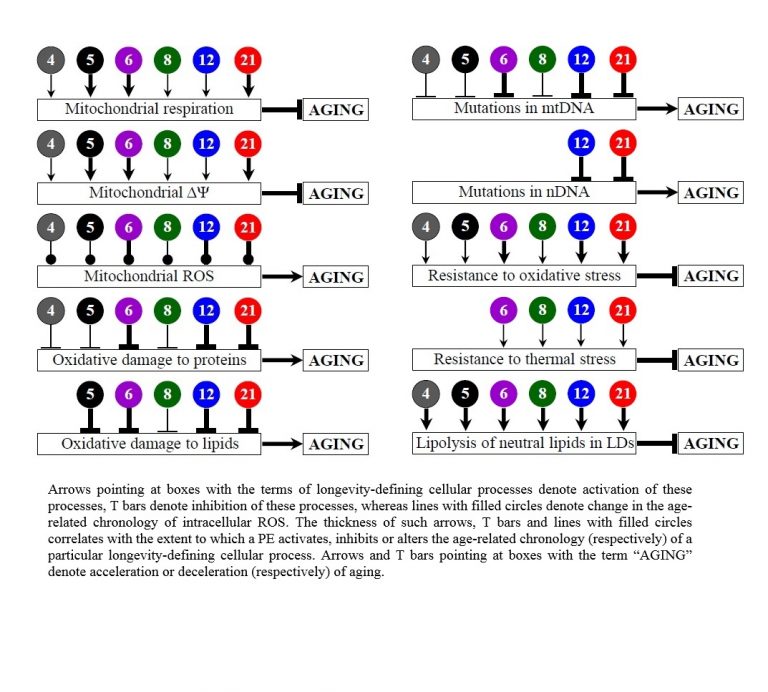
The Research
Eric Simard, Doctor in Biology and researcher in the field of aging, is behind an ambitious research program supported by the Natural Sciences and Engineering Research Council of Canada. This research program focuses on the identification of new molecules capable of slowing down the primary aging of an organism.
Directed Prevention
The term “DIRECTED PREVENTION” comes from the recipient of a large number of scientific awards, DNA repair specialist and member of the Academy of Sciences, MiroslavRadman (link to his video below):
It is possible to act on aging through directed prevention!
How is it possible? We already know that the approaches that specifically target a single mechanism of action have little effect on primary aging. For example, taking antioxidants like vitamin E or vitamin C is not as effective as directly stimulating the cells’ natural antioxidant mechanisms.
This is part of the answer. Species that live longer, compared to similar animals, usually have much higher resistance to cellular oxidation, as well as maintenance and repair mechanisms which remain active for much longer. Here, we are referring to DNA repair, damaged proteins, cellular recycling processes (autophagy), etc. If we add to this, the maintenance in good health of the mitochondria (our energy producers which are at the heart of aging processes and a large number of diseases), we obtain healthy aging. This is how, by increasing our resistance to aging and keeping our mitochondria healthy, it will be possible to prevent a large number of diseases associated with aging (by reducing their incidence).
The objective of our research is therefore to discover molecules to uphold all the mechanisms of maintenance and functional repair, to stimulate our cellular antioxidant defenses and to keep our mitochondria healthy.
The following figure shows the impact of some of our findings on ten cellular factors affecting longevity. These are the best results seen so far. We have, of course, filed patents on these important discoveries.

These are new hopes; much research remains to be done before confirming these results in humans. In addition, it will certainly be necessary; in order to put the odds in one’s favor, to eat well, to do regular physical activity, to manage stress and anxiety well, and to have a committed social life. It is therefore important above all to make sure you have healthy lifestyle habits.
Advanced Research
The program, which has been running since 2013, aims to identify new modulators of primary aging (which can slow aging), understand the mechanisms of action involved and identify possible applications related to diseases associated with aging. 5 universities and a specialized research center participated in this work. Currently, research work is carried out at Concordia University and at Transbiotech; a research center specializing in biotechnology.
This research program has already identified the best modulators of primary aging described thus far. The current work will make it possible to study in more depth the impact of the first 6 modulators discovered in 2016 (patents pending), as well as the mechanisms of action of several others discovered in 2017, which have not yet been released publicly.
The collaboration of the three partners makes it possible to maximize the strengths of each: Idunn Technologies provides specific natural extracts; Concordia University has study models allowing the identification of the mechanisms of actioninvolved in the slowing down of aging or the increase in repair capacities of the organism,Transbiotech has cutting-edge purification and analysis facilities at its finest that identify the best natural molecules involved and verify their bioactivity.
About research on aging
This research has great potential for spinoffs and, as Dr. James L. Kirkland, director of the Kogod Center on Aging at the Mayo Clinic points out: “By targeting fundamental aging processes, it may be possible to delay, prevent, alleviate or treat the major age-related chronic disorders as a group instead of one at a time”- Excerpt from Aging : The Longevity Dividend, 2016.
These words were quoted in an article in the New York Times dated February 1, 2016, and mentioned the considerable economic impact that this approach could have.
The great American specialist, Dr. Matt Kaeberlein of the University of Washington, had already published, at the end of 2015, in the prestigious scientific journal SCIENCE Healthy aging: The ultimate preventive medicine (Healthy aging: The ultimate preventative medicine. 2015 Dec 4; 350 (6265): 1191-3). The ultimate preventive medicine, noted by Dr. Kaeberlein, is precisely the objective of the Quebec research program: slowing down primary aging.
High-level scientific publications
This cutting-edge work on primary aging research has resulted in the training of a large number of graduate students and the publication of several high-level scientific articles. In 2016, DrTitorenko’s laboratory, in collaboration with Idunn Technologies, already announced important discoveries published in ONCOTARGET, prestigious scientific journal specialized in aging : Discovery of new groups of anti-aging molecules. In September of the same year, in this same specialized journal, a second publication confirmed the main mechanisms of action involved : Six new groups of molecules could be used to slow aging.
More recently, in March 2019, this research was making headlines following the publication of even more important results, still in this prestigious scientific journal : Six plant extracts form synergistic pairs to slow aging in yeasts – and possibly humans, shows new study.
Suggested references
For those who would like to read scientific articles on primary aging, here are some links of interest :
- Longo et al, 2015. Interventions to Slow Aging in Humans: Are We Ready?
- Matt Kaeberlein, 2015. Healthy aging: The ultimate preventative medicine.
- Carmona and Michan, 2016. Biology of Healthy Aging and Longevity.
- Campisiet al, 2019. From discoveries in ageing research to therapeutics for healthy ageing.
- de Pabloset al, 2019. Hydroxytyrosol protects from aging process via AMPK and autophagy; a review of its effects on cancer, metabolic syndrome, osteoporosis, immune-mediated and neurodegenerative diseases.
Published articles from the research program
2020
Discovery of fifteen new geroprotective plant extracts and identification of cellular processes they affect to prolong the chronological lifespan of budding yeast.
https://www.oncotarget.com/article/27615/text/
2019
- Pairwise combinations of chemical compounds that delay yeast chronological aging through different signaling pathways display synergistic effects on the extent of aging delay.
https://www.oncotarget.com/article/26553/text/ - Mechanisms by which PE21, an extract from the white willow Salix alba, delays chronological aging in budding yeast.
https://www.oncotarget.com/article/27209/text/
2017
- Caloric restriction extends yeast chronological lifespan via a mechanism linking cellular aging to cell cycle regulation, maintenance of a quiescent state, entry into a non-quiescent state and survival in the non-quiescent state.
https://www.oncotarget.com/article/20614/text/
2016
- Six plant extracts delay yeast chronological aging through different signaling pathways.
https://www.oncotarget.com/article/10689/ - Discovery of plant extracts that greatly delay yeast chronological aging and have different effects on longevity-defining cellular processes.
https://www.oncotarget.com/article/7665/text/
2015
- Longevity Extension by Phytochemicals.
https://www.mdpi.com/1420-3049/20/4/6544 - Mechanisms by Which Different Functional States of Mitochondria Define Yeast Longevity.
https://www.mdpi.com/1422-0067/16/3/5528

